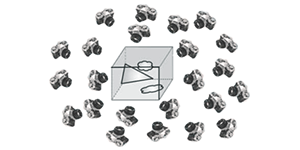March 15, 2013


Google X Lab, sometimes known as Google X, is a secret facility run by Google thought to be located somewhere in the Bay Area of Northern California. Work at the lab is overseen by Sergey Brin, one of Google’s co-founders. Reportedly worked on at the lab is a list of 100 projects pertaining to future technologies such as a space elevator, self-driving car, augmented reality glasses, a neural network that uses semi-supervised learning, enabling speech recognition and extraction of objects from video – for instance detecting if a cat is in a frame of video, and the Web of Things (a network of objects with embedded computers).
Project Glass is a research and development program by Google to develop an augmented reality head-mounted display (HMD). The intended purpose of Project Glass products would be the hands-free displaying of information currently available to most smartphone users, and allowing for interaction with the Internet via natural language voice commands.
read more »
Posted in Money, Technology |
Leave a Comment »
March 15, 2013

Solve for X is a think tank project launched by Google to incite collaboration to solve global issues, ‘X’ representing a remedy. The project kicked off in 2012 at a three-day convention at CordeValle Resort in San Martin, California. ‘Solve for X’ talks were presented to 50 people, hosted by Google executives Eric Schmidt, Astro Teller, and Megan Smith.
Solve for X was initially believed to be linked to the Google X Lab working on new technology such as web-connected appliances, driverless cars, and space elevators, but ‘eWeek’ reported that Google X is wed to more realistic undertakings, not the ‘moonshot’ solutions ‘Solve for X’ was created to pursue.
Posted in Money, Technology |
Leave a Comment »
March 15, 2013

Saul Griffith is an Australian American inventor. He is best known for his inexpensive technique for making prescription eyeglasses. This method uses two flexible surfaces and a pourable resin. Saul Griffith was born into an academic family, and encouraged to question all around him, to experiment as a process of learning, and to communicate effectively.
He won a scholarship to study Material Science at the University of New South Wales where he graduated in 1997 with a Bachelor of Metallurgical Engineering. In 2000, Griffith graduated from the University of Sydney with a Master of Engineering degree. He won a scholarship to MIT Media Lab to study towards a PhD that he completed in 2004. The subject of his PhD Thesis was ‘self replicating machines.’ They were one of the first instances of artificial replication being demonstrated using real physics.
Posted in Technology |
1 Comment »
March 15, 2013

Bullet time is a special and visual effect that refers to a digitally enhanced simulation of variable-speed (i.e. slow motion, time-lapse). It is characterized both by its extreme transformation of time (slow enough to show normally imperceptible and unfilmable events, such as flying bullets) and space (by way of the ability of the camera angle—the audience’s point-of-view—to move around the scene at a normal speed while events are slowed).
This is almost impossible with conventional slow-motion, as the physical camera would have to move impossibly fast; the concept implies that only a ‘virtual camera,’ often illustrated within the confines of a computer-generated environment such as a virtual world or virtual reality, would be capable of ‘filming’ bullet-time types of moments. Technical and historical variations of this effect have been referred to as time slicing, view morphing, slow-mo, temps mort, and virtual cinematography.
read more »
Posted in Art, Games, Technology |
Leave a Comment »
March 15, 2013


Slow motion (commonly abbreviated as slowmo) is an effect in film-making whereby time appears to be slowed down. It was invented by the Austrian priest August Musger. Typically this style is achieved when each film frame is captured at a rate much faster than it will be played back.
When replayed at normal speed, time appears to be moving more slowly. A term for creating slow motion film is ‘overcranking’ which refers to hand cranking an early camera at a faster rate than normal (i.e. faster than 24 frames per second). Slow motion can also be achieved by playing normally recorded footage at a slower speed. This technique is more often applied to video subjected to instant replay, than to film.
read more »
Posted in Art, Technology |
Leave a Comment »
March 15, 2013

Tachypsychia [tak-ee-sahy-kee-uh] is a neurological condition that alters the perception of time, usually induced by physical exertion, drug use, or a traumatic event. It is sometimes referred to by martial arts instructors and self defense experts as an ‘adrenaline dump.’
For someone affected by tachypsychia events appear to slow down and objects appear as moving in a speeding blur. It is believed that tachypsychia is induced by a combination of high levels of dopamine and norepinephrine, usually during periods of great physical stress and/or in violent confrontation. Tachypsychia is related to the ‘fight or flight’ response of the body to events considered life threatening.
read more »
Posted in Health, War |
Leave a Comment »









